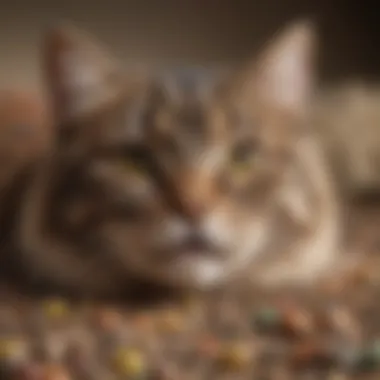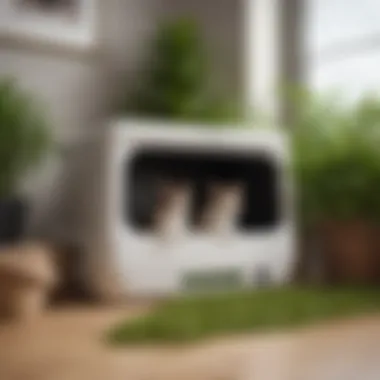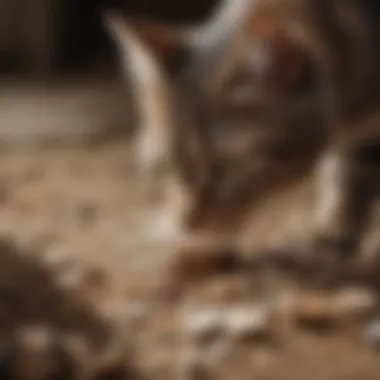Top Compostable Cat Litters: Eco-Friendly Choices


Intro
As pet owners, we constantly find ourselves navigating a balancing act between our furry companions' needs and our responsibilities to our planet. Amid the ever-growing concern for environmental sustainability, compostable cat litter emerges as a legitimate contender against traditional clay options. This guide will take you on a journey through the nuances of compostable cat litter—its benefits, different types available, and standout products that could redefine your feline’s restroom experience while being kind to the environment.
At its core, compostable cat litter is not merely a trend; it forms a significant part of a lifestyle shift towards more sustainable pet care routines. As we delve deeper into this subject, we aim to provide clarity and guidance for pet owners eager to make informed choices that positively impact our ecosystem.
Throughout this article, you’ll discover insights on what defines compostable cat litter, practical tips for using it effectively, and reviews on top-rated products that have captured the hearts of eco-conscious pet owners. We'll also tackle potential downsides, offering guidance on overcoming challenges that might arise during the transition.
Unless you’ve been living under a rock, you’re aware of the adverse effects that plastic and other non-biodegradable materials wreak on our planet. Switching to compostable litter is a step forward, presenting not just a product choice but a broader philosophy of care. Now, let’s get down to the nitty-gritty of understanding this eco-friendly alternative for your beloved feline.
Understanding Compostable Cat Litter
The topic of compostable cat litter is more significant than meets the eye. As pet owners ponder the impact of their choices on the environment, the shift towards sustainable alternatives cannot be overstated. Compostable cat litter offers an innovative solution that aligns with increasing environmental consciousness. By opting for these products, pet owners not only ensure a cleaner home for their furry companions but also contribute positively to our planet's welfare.
Definition and Composition
Compostable cat litter is designed to break down naturally, minimizing its environmental footprint. Typically, these litters are crafted from organic materials such as corn, wheat, wood, or even recycled paper. The composition varies widely; for example,
- Corn-based litters harness the natural absorbency of corn kernels.
- Wheat-based options utilize the natural starches in wheat, which clump effectively and control odor.
- Wood and paper litters supply an alternative by repurposing materials that might otherwise contribute to landfill waste. This biologically-friendly composition stands in stark contrast to traditional clay litters, which are generally synthetic and non-biodegradable.
Understanding the makeup of these litters provides insight not just into their functionality but also their contributions to both your cat's health and broader environmental conditions.
Comparing with Traditional Cat Litter
When considering the differences between compostable cat litter and traditional clay options, the divergences are evident. Traditional clay litter is derived from sodium bentonite, a material that is strip-mined, leading to habitat destruction and significant environmental tolls. In terms of performance, while clay litter is known for its excellent clumping abilities and odor control, it fails to offer the eco-friendly benefits that compostable alternatives proudly uphold.
Moreover, the end-of-life aspect can't be overlooked. Clay litter often ends up in landfills, where it can take years to break down. In comparison, compostable litters can decompose into rich compost, enhancing soil quality in the process. The contrast begs the question of what kind of legacy pet owners want to leave. A deeper connection with sustainable living is developed when one recognizes these key differences in both performance and impact.
Environmental Impact
The environmental repercussions of yard waste and litter disposal have become an increasingly illuminated subject. Compostable cat litter contributes favorably here for several reasons:
- Reduction in landfill waste: With traditional litters contributing significantly to landfills, composting these organic materials helps decrease the overall burden.
- Fostering biodiversity: When composted properly, these litters enrich the soil, aiding plant growth and supporting healthy ecosystems.
- Sustainable sourcing: Many compostable litters use renewable resources, diminishing the reliance on fossil fuel-derived materials found in conventional options.
In many ways, using compostable cat litter sends a message. By making this conscious choice, pet owners not only care for their cats but also take a firm stance in the fight against environmental degradation. This mindset fosters a responsible relationship between pets and the planet, paving the way for a healthier future for both.
Types of Compostable Cat Litter
When considering compostable cat litter, understanding the various types available is paramount. Each category offers distinct properties, advantages, and potential drawbacks that may suit your household’s needs and your feline's preferences. Opting for compostable litter isn't merely about being eco-conscious; it’s about ensuring optimal comfort and health for your pet as well. We will explore the qualities of the main categories of compostable cat litter, providing insight into how they function, their benefits, and what to keep in mind when making a choice.
Plant-Based Litters
Plant-based litters primarily consist of materials derived from renewable sources, making them a favorite among environmentally conscious pet owners. Common ingredients include materials like soy, coconut, and even various grains. These litters are typically lightweight, and many offer excellent absorption capabilities. One of the standout benefits is their natural biodegradability.
A notable example is the use of bamboo, which grows rapidly and requires minimal resources to cultivate. It’s a sustainable option that decomposes well after disposal. However, the key to selecting a quality plant-based litter lies in checking its packaging for certifications and ensuring that it is indeed free from harmful chemicals that could impact your cat’s health. Additionally, while some brand offer great odor control, not all plant-based litters are created equal in that department.
Wood and Paper Litters
Wood and paper litters have gained traction for their ability to absorb moisture and control odors effectively. Utilizing recycled paper or sawdust, this type of litter can be a fantastic option for those looking to minimize waste. Many manufacturers process wood chips through a process that makes them ultra-absorbent and low-dust, which is a boon for both cats and their owners.
One thing to consider, however, is the grainy texture these litters often offer. While many cats have no issues adjusting, some may take a longer time to adapt compared to softer alternatives. Also, the particular scent of wood might not appeal to every feline, so observing your cat’s reaction during transition is essential. Stick to reputable brands that specify the type of wood used, as some may offer enhanced smell control over others.
Corn-Based Litters
Corn-based litters are made from dried and processed corn and have become increasingly popular. They score high on clumping ability, which can make cleaning the litter box a breeze. The natural properties of corn help in odor control as well, often outperforming some traditional clay litters in that department. Moreover, these types are generally loved for their soft texture which is comfortable for cats’ paws.
On the downside, corn-based litter may not be suitable for all cats, especially those with allergies or sensitivities to corn. Also, while they are biodegradable, their effectiveness can diminish in damp environmental conditions, potentially leading to less efficient odor control over time. It's crucial to keep this in mind if you live in a more humid region or don't dispose of waste quickly enough.
Wheat-Based Litters
Wheat-based litters utilize processed wheat, providing a natural, biodegradable alternative with commendable clumping properties. The ingredients often include wheat gluten, which binds moisture and minimizes mess. Cats typically adapt well to the texture, which closely resembles clay in some popular products.


Furthermore, wheat is renowned for its natural antimicrobial qualities, offering additional protection against odors and bacteria. However, just like with corn-based options, wheat litter can be problematic for cats with wheat allergies. In addition, not all wheat-based litters feature pure ingredients, so it’s advisable to inspect the label for fillers or additives that might not align with your preferences.
In summary, selecting the right type of compostable cat litter hinges on understanding the specific needs of your cat, as well as your own values related to sustainability and environmental impact.
Key Features to Consider
When it comes to choosing the right compostable cat litter, several key features stand out. Pet owners must consider these elements to ensure they are making an informed decision that benefits not just their feline friends, but also the environment. Absorption and odor control, dust production and cleanliness, clumping ability, and cost-effectiveness play vital roles in the overall performance and user experience of cat litter. Here’s a closer look at each of these features.
Absorption and Odor Control
Effective moisture absorption is crucial in any cat litter. If a litter can’t absorb liquid properly, it becomes soggy and loses its effectiveness, which can lead to unpleasant odors. Compostable litters must be evaluated on how well they manage absorbency. For example, litter made from corn tends to have superior absorption capabilities, soaking up moisture much like a sponge. This characteristic reduces odors and keeps the environment fresher for both cats and their owners.
Furthermore, many compostable litters come with natural additives that enhance odor control. For instance, some formulas incorporate baking soda or specific plant ingredients known for their ability to neutralize odors. Choosing a litter with both high absorption and effective odor control will make for a better experience in maintaining your pet's litter box.
Dust Production and Cleanliness
Dust creation is another aspect worth considering. Traditional clay litters can create significant dust clouds, leading to respiratory issues for both pets and humans. Compostable litters often generate less dust, which is a considerable benefit, especially for cats with sensitive respiratory systems. Products made from paper or wood fibers typically have low dust levels. This not only makes the litter box cleaner but also enhances the overall air quality of your home.
Keeping a litter box clean can be a tussle, so having a product that minimizes dust is a boon. It's worth noting that materials like recycled paper shreds not only keep dust at bay but also add to the overall cleanliness of the litter area, reducing the need for constant sweeping and cleaning.
Clumping Ability
Clumping cat litter forms solid spheres when wet, making it easier to scoop and maintain the box. However, not all compostable options offer this feature. While some plant-based litters do clump effectively, others may not provide the same level of performance, leading to messier clean-ups. Potential users should look for reviews that highlight clumping ability, as a poorly clumping product may cause frustration for both pet owners and their cats.
For instance, wheat-based litters often form decent clumps that are simple to remove, while other options like those made from coconut coir may struggle in that area. This can affect the overall user experience, so weighing clumping ability against absorption and odor control is essential.
Cost-Effectiveness
Lastly, the price point of compostable cat litter deserves attention. While many eco-friendly litters can be more expensive than their traditional counterparts, the long-term benefits may justify the initial investment. Considering factors such as the product's lifespan and its overall performance can provide clarity.
When evaluating cost-effectiveness, consider:
- How frequently will you need to change the litter?
- Do you need to buy additional products for odor control?
- Does the litter maintain its performance over time, or does it break down quickly?
Your choice should balance quality and price, ensuring you get the best bang for your buck without compromising on your pet's comfort and the environment.
"Choosing the right compostable cat litter is about more than just picking a brand; it’s about ensuring a healthy and sustainable future for your pet and the planet."
Top Picks for Compostable Cat Litter
Finding the right compostable cat litter can feel a bit like trying to find a needle in a haystack, especially with so many options available nowadays. It’s not just about choosing the first one that looks good; this choice has implications for your pet's health, the cleanliness of your home, and the environment as a whole. Thus, underlining effective options is crucial. The best compostable cat litters encompass eco-friendliness while meeting the practical needs of cat owners. In this section, we delve into specific brands and their offerings. We’ll break down what makes each product stand out and why they are highly regarded in the realm of sustainable pet care.
Brand Reviews and Recommendations
Product A: Features and Benefits
When it comes to eco-conscious choices, Product A stands out for its high absorbency. Made from reclaimed materials, this litter absorbs moisture better than a sponge. Cat owners who have switched to this product often remark on its effectiveness in controlling odors without heavy perfumes, which can sometimes be a deal-breaker for felines sensitive to scents. Its clumping ability is another feather in its cap, making cleanup a breeze. The unique attribute of Product A is that it breaks down in composting systems quite easily, contributing to its reputation as a fantastic choice for the environmentally aware. Although some might find it slightly pricier than traditional options, the benefits it delivers often justify the investment.
Product B: Features and Benefits
Product B takes a different approach by utilizing 100% plant-derived ingredients. This choice has won over many pet owners, especially those keen on minimizing environmental impact. Its grains create a lightweight litter that still manages to pack a punch in terms of absorption. Many users rave about its low dust production, making it a more pleasant experience during scooping. What sets Product B apart is its unique formulation that helps keep paws clean post-use, reducing the need for constant floor cleaning. While its price point might raise eyebrows, the quality and performance can often outweigh the financial concern for dedicated pet owners.
Product C: Features and Benefits
Product C rounds out our picks with a focus on a blend of wood and paper. This product offers a rustic charm, without compromising functionality. The sawdust particles break down odors effectively, creating a more pleasant environment in your home. What makes Product C especially appealing is its biodegradable nature, allowing it to decompose more rapidly in a compost setting compared to other litters. Many customers appreciate that it's made with minimal processing, which aligns well with sustainable living goals. However, a common drawback mentioned is the potential for more frequent litter changes due to lower clumping capabilities. Despite this, its advantages make it a reputable choice within the compostable category.
User Ratings and Feedback
User feedback is invaluable when navigating the compostable cat litter landscape. Many pet owners have shared their experiences on community platforms. In general, products that offer both superior odor control and minimal dust seem to garner the most praise. Often, testimonials highlight the shift to these options as not only beneficial for the environment but also as a way to cultivate healthier living spaces for both pets and humans.


More than just ratings, individual feedback provides insight into practicality in everyday life with cats. For many, their feline family members are discerning critters, so their acceptance of new litter warrants serious attention. Users frequently encourage others to monitor their pets’ reactions closely during the transition to compostable options to pinpoint what works best for their feline friends.
Pros and Cons of Compostable Cat Litter
When considering alternatives to traditional cat litter, the pros and cons of compostable cat litter is a topic worth exploring. This section dives deep into the various facets of compostable options, as they hold significance not only for your feline friends but also for the environment. Understanding these merits and drawbacks can help you make informed decisions that align with eco-conscious living and responsible pet ownership.
Advantages
Environmental Benefits
One of the standout aspects of compostable cat litter is its positive impact on our environment. Unlike clay litters, which are often derived from non-renewable resources, compostable litters are made from sustainable materials like corn, wood, or paper. This shift away from petroleum-based products means less waste in landfills and a reduced ecological footprint.
Moreover, many compostable litters decompose naturally, returning vital nutrients back to the soil instead of hanging around for centuries like traditional litter. This aspect makes them quite popular among environmentally-minded consumers who want to leave a lighter imprint on the planet.
„Choosing compostable litter is not just a benefit to your cat but a step toward a sustainable future.”
Health Considerations for Pets
The health of our pets is paramount, and compostable cat litters tend to be a safer option for them. Many conventional cat litters contain synthetic additives and chemicals that can be harmful if ingested or inhaled. On the other hand, most compostable varieties are made from natural, plant-based materials that are less likely to irritate your cat's respiratory system or cause digestive issues.
By opting for a natural product, you're not just supporting a healthier planet but also nurturing your pet's well-being. The less processed, the better for your furry buddy.
Disadvantages
Cost Implications
While the environmental and health benefits are appealing, the cost implications can be a hard pill to swallow. Generally speaking, compostable cat litters often come with a higher price tag when compared to standard clay options. This difference in price can be a significant factor for pet owners balancing their budgets. While it's easy to see compostable options as a premium choice, understanding your financial limits is key to avoiding an unsustainable routine.
The added cost might be justified for some, but it's essential to weigh it against your budget. If you’re making significant lifestyle changes, the extra expense might disrupt your financial balance.
Performance Issues
Another glaring concern surrounding compostable cat litter is related to performance issues. Depending on the brand and type, some compostable litters may not clump as well or may lack sufficient odor control compared to their clay counterparts. Cat owners often rely on consistent performance in terms of absorbing moisture and containing smells. If a product falls short in these areas, it can lead to frustration not just for you but also for your feline companion.
It’s important to keep in mind that not every compostable litter will meet the same performance standards. Finding a reliable option might take a bit of trial and error, which can be off-putting for many.
How to Transition to Compostable Cat Litter
Switching to compostable cat litter can be an exciting step in going green, but it requires some careful planning. Understanding how to effectively transition your feline friend from traditional litter to a compostable option can save you headaches down the road and keep your kitty happy. It’s about more than just a product change; it involves a thoughtful approach that respects your cat’s unique habits and preferences.
Gradual Preface Methods
Cats are notoriously picky creatures. A sudden change in their litter can throw them off their game completely. To ease the transition, consider the gradual introduction method. Here’s how you do it:
- Mix the Litters: Start by mixing a small amount of compostable litter with the current litter your cat is accustomed to. Over a week or so, gradually increase the proportion of compostable litter. This allows your cat to get used to the new texture and smell at their own pace.
- Different Boxes: If you have multiple litter boxes, dedicate one of them solely to the new litter while keeping others with the old type. This way, your cat has the choice and can explore the new option without feeling forced.
- Positive Reinforcement: Every time your cat uses the compostable litter, reward them with treats or affection. This creates a positive association with the new type and encourages them to use it again.
Transitioning doesn’t happen overnight. Patience is key. Each cat is unique, and some might take longer to adapt than others.
Monitoring Your Cat's Adaptation
As the transition unfolds, it’s crucial to keep an eye on your cat’s behavior. Here are some things to watch for:
- Usage Frequency: Is your cat using the new litter? If they start avoiding it, it might signify discomfort or disinterest. You may need to adjust how you're introducing the new litter.
- Litter Box Habits: Look out for any unusual changes in their litter box routine. If accidents start happening outside the box, it could be related to the new litter's texture or smell.
- Physical Symptoms: Monitor for any signs of stress or discomfort that may arise due to the change. If your cat seems anxious or exhibits changes in eating habits, it may be time to reassess the situation.
Patience pays off. Slowly adapting to a new environment brings the best long-term results.
By paying attention to these signs, you can better understand your cat's comfort level. If issues arise, consider reverting back to the original litter for a bit before trying again. Ultimately, a successful transition not only benefits the environment but ensures your pet’s well-being.
Disposal Methods for Compostable Cat Litter
When it comes to compostable cat litter, understanding the appropriate methods for disposal is crucial. Proper disposal not only ensures that you’re sticking to eco-friendly practices, but it also contributes to the overall health of your household environment. Considering that compostable litters are often made from natural materials, the ways in which we dispose of them can significantly influence their effectiveness and sustainability. Let's break down a couple of key aspects that every pet owner should take to heart.
Composting Guidelines


Composting cat litter is one of the best options for disposal. However, it’s essential to do it right. Here's a rundown of best practices for composting:
- Choose the Right Compost Bin: Select a compost bin that’s specifically designed for pet waste. Opt for a system that allows for easy aeration and drainage. This helps in breaking down organic matter more effectively.
- Mix It Up: When adding litter to your compost, blend it with brown materials like dried leaves, straw, or shredded paper. This helps balance nitrogen-rich materials in the litter, improving compost health.
- Monitor Temperature: Keep an eye on the temperature of the compost pile. A compost temperature between 130°F and 160°F is ideal for breaking down waste effectively and killing pathogens.
- Wait Before Use: Once your compost is ready, avoid using it on edible plants for at least 90 days. This waiting period is important to ensure that any remaining pathogens are neutralized.
- Know What Not to Compost: Avoid adding litter made from synthetic materials or any chemical-heavy products to your compost. Stick to those compostable litters made from natural sources like corn or wheat.
Tip: Community composting options may also be available, which can be a great choice if you lack space or resources. Always check local regulations regarding pet waste composting as they may vary by area.
General Waste Disposal Tips
In cases where composting isn’t an option, there are still responsible ways to dispose of your compostable cat litter. Here are some pointers:
- Biodegradable Bags: Use biodegradable bags for easy disposal. This way you can manage the waste without adding to plastic pollution.
- Seal it Tight: Ensure that you seal your waste bags tightly to contain odors and prevent any leaks. Unpleasant smells can draw in pests, making it a transformation from bad to worse.
- Local Disposal Regulations: Be mindful of local disposal laws. Some areas have specific guidelines on how to dispose of pet waste, even if it’s compostable. It’s important to stay informed.
- Regular Disposal: Don't let the waste pile up. Frequency of disposal is key. Aim to dispose of the litter at least once a week to avoid any unpleasant surprises later.
Both composting and general disposal methods provide solutions for pet owners wishing to lessen their environmental impact. Making informed choices when disposing of cat litter plays a big part in sustainable pet ownership.
These practices not only align with eco-friendly values, but they also demonstrate that taking care of a pet can be done responsibly, ensuring a cleaner planet for the next generation.
Frequently Asked Questions
In the realm of compostable cat litter, addressing common queries is crucial for guiding both seasoned pet owners and those new to the concept. Having a dedicated section for frequently asked questions acts as a beacon of clarity amid the sea of choices available in today’s market. It not only demystifies compostable options but also builds confidence in making informed purchases. Let’s tackle some key inquiries that often arise.
Is compostable cat litter truly biodegradable?
When discussing compostable cat litters, the term "biodegradable" is thrown around quite a bit, but what does it really mean? In essence, compostable cat litter must break down into natural elements in a compost environment, thus enriching the soil rather than leaving a harmful residue.
Most compostable options are made from organic materials such as corn, wheat, or recycled paper, which naturally decompose. However, not all products labeled as compostable act the same way. Some litter brands may include synthetic additives that can prevent full decomposition. To ensure that what you are purchasing truly breaks down, look for certifications or third-party testing results.
Here are a few key points to consider when evaluating if a specific cat litter is truly biodegradable:
- Materials Used: The base ingredients should be natural and sustainably sourced.
- Certification: Look for clear labels, such as ASTM D6400 or EN13432, which confirm compostability standards.
- Local Conditions: Keep in mind that conditions in home compost systems may vary, so some products may break down differently at home compared to a commercial compost facility.
As consumers become more aware of the importance of sustainability, understanding the true nature of compostable cat litter becomes ever more vital.
How does it compare to clay litter in terms of odor control?
Odor control is a significant concern for cat owners, as maintaining a fresh-smelling home is essential for both human and feline enjoyment. When comparing compostable cat litter with traditional clay alternatives, one might wonder how effective these eco-friendly choices are in handling odor.
Compostable litters, especially those made from materials like corn and wheat, often boast impressive absorbency qualities. Here’s a breakdown of their capabilities:
- Natural Absorbents: Many compostable options leverage natural absorbent properties, helping to trap odors effectively. This can be a noteworthy advantage over clay litters, which rely on heavy processing.
- Microbial Action: Some compostable litters work by promoting healthy microbial action that effectively neutralizes smells rather than just masking them, a method less common in traditional clay options.
- Clumping Capabilities: While many clay litters form solid clumps, some compostable types are catching up, providing decent clumping abilities that aid in easy cleanup and odor management.
But it's worth noting that, while many users report satisfaction with the odor control of compostable litters, individual experiences may vary. The effectiveness can depend on the specific product, the cat’s diet, and the frequency of litter changes.
"Finding the right balance between eco-friendliness and practicality can take some trial and error, but the benefits often outweigh the challenges for many conscientious owners."
Future of Cat Litter Choices
As more individuals and families make a conscious effort to lessen their ecological footprint, the future of cat litter is poised for significant change. Shifting away from traditional materials and methods towards more sustainable options reflects a growing awareness about environmental issues. It's not just a fad; it's a movement aiming to redefine pet care. The conversation around compostable cat litter is crucial for pet owners, eco-enthusiasts, and those looking for healthy alternatives for their furry companions. This shift considers not only the immediate needs of our pets but also our collective responsibility toward the planet.
Innovations in Eco-Friendly Litters
Innovation is the name of the game in the world of eco-friendly cat litter. Over recent years, numerous companies have launched cutting-edge products specifically designed to cater to the changing preferences of pet owners. Some notable advancements include:
- Biodegradable materials: Many brands are now crafting litters from fast-renewing resources like bamboo, coconut coir, and recycled paper. These materials break down much more swiftly compared to traditional clay litters.
- Enhanced odor control: Traditional litters often struggle with odors, but newer compostable litters are incorporating natural absorbents. For example, baking soda or essential oils can be added to enhance freshness without harmful chemicals.
- Improved clumping technologies: Modern formulations boast superior clumping properties. This means easier cleaning without sacrificing compostability, letting users enjoy a more manageable litter box.
These innovations not only offer practical solutions but also align with customer values—putting environmental concerns at the forefront of feline health and hygiene.
Consumer Trends and Preferences
Increasingly, consumers are seeking products that align with their values. Survey data indicates that pet owners are more inclined to choose options that promise sustainability and health benefits. A few key trends have emerged in this realm:
- Transparency in sourcing: Today’s consumers care about where and how products are made. Brands are responding by providing detailed information regarding their sourcing practices, fostering trust and loyalty.
- Multi-functional products: Buyers appreciate litters that serve more than one purpose. For instance, some plant-based litters can also be used—safely and effectively—in compost heaps or even in gardens.
- Influence of social media: Nowadays, platforms like Reddit and Facebook are buzzing with discussions about pet care. This can influence buying choices and trends, pushing brands towards greener solutions.
"In a world where choices multiply, consumers gravitate towards brands that not only speak but act on sustainability."
Focusing on these trends can assist brands in aligning their products with consumer expectations, ultimately paving the way for a greener future in the cat litter market.















